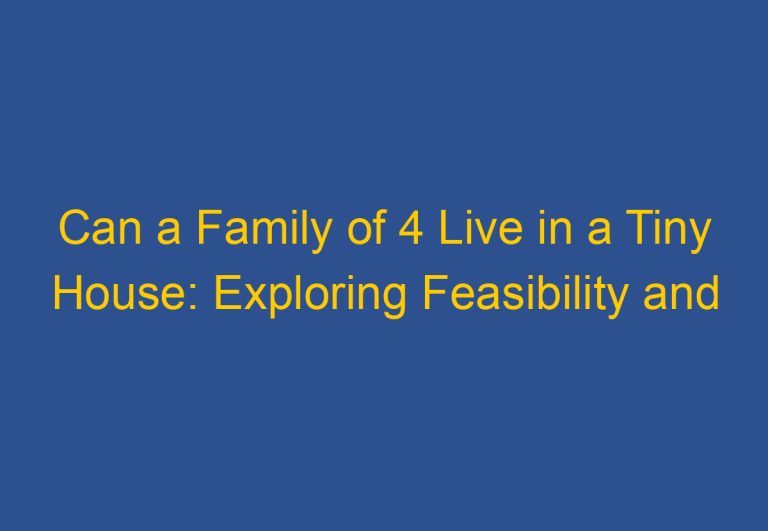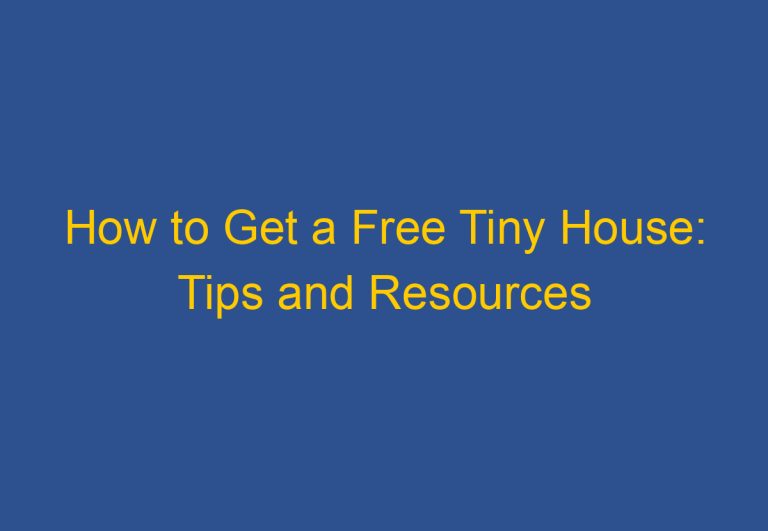How to Buy a Tiny House: A Comprehensive Guide
Tiny houses are becoming increasingly popular among those who want to downsize their living space, reduce their carbon footprint, or save money on housing expenses. However, buying a tiny house is not as straightforward as purchasing a traditional home. There are several factors to consider, such as the type of tiny house, the cost, and the legal regulations in your area.
One of the first things to consider when buying a tiny house is the type of tiny house that best suits your needs. There are several types of tiny houses available, including mobile tiny homes on wheels, stationary tiny homes, and DIY tiny house kits. Mobile tiny homes on wheels are ideal for those who want the flexibility to move their home from one location to another. Stationary tiny homes are typically more affordable and may be a good option for those who want a permanent home. DIY tiny house kits are a popular choice for those who are handy and want to build their own tiny house from scratch.
Another important factor to consider when buying a tiny house is the cost. The cost of a tiny house can vary widely depending on factors such as size, materials used, and whether it is pre-built or DIY. According to Rocket Homes, a stationary prefab tiny home can range anywhere from $35,000 to $68,000, while a mobile prefab tiny home averages between $60,000 to $80,000. Custom builds have the largest range, and can start anywhere from $25,000 up to $150,000 or more. It is important to determine your budget before starting your search for a tiny house.
Legal regulations are also an important consideration when buying a tiny house. Zoning laws and building codes vary from state to state and even from city to city, so it is important to research the regulations in your area before purchasing a tiny house. Some areas may not allow tiny houses at all, while others may require permits or inspections. It is important to ensure that your tiny house meets all legal requirements before making a purchase.
Understanding the Tiny House Movement
Defining Tiny Houses
Tiny houses are small, compact homes that are typically under 500 square feet in size. They can be built on a foundation or on wheels, and are designed to be functional and efficient. The tiny house movement is a social movement that has gained popularity in recent years, with people choosing to downsize their living spaces and live more simply. Tiny houses can be customized to fit the unique needs and preferences of their owners, and can be used as permanent residences or as vacation homes.
History and Evolution of Tiny Houses
The tiny house movement has its roots in the minimalist and environmentalist movements of the 1960s and 70s. However, it wasn’t until the 1990s that the concept of tiny houses really began to gain traction. In recent years, the popularity of tiny houses has exploded, with more and more people choosing to downsize their living spaces and live more sustainably. Today, there are a variety of tiny house designs and styles available, from rustic cabins to sleek, modern homes.
Benefits of Living in a Tiny House
There are many benefits to living in a tiny house. One of the most obvious benefits is the cost savings. Tiny houses are typically much cheaper to build and maintain than traditional homes, and can be customized to fit a range of budgets. In addition, tiny houses are often more sustainable than traditional homes, with many owners choosing to incorporate eco-friendly features such as solar panels and composting toilets. Tiny houses are also highly customizable, with owners able to design their homes to fit their unique needs and preferences. Finally, tiny houses offer a simpler, more minimalist lifestyle, which can be appealing to those looking to simplify their lives and focus on what really matters.
The Buying Process
Purchasing a tiny house can be an exciting and rewarding experience. However, it does require some planning and research to ensure that you make the right decision. In this section, we will discuss the key steps involved in the buying process.
Planning Your Tiny House Purchase
Before you buy a tiny house, it is important to consider your needs and budget. Think about the size and type of tiny house that would be best suited for you. Do you want a mobile or stationary tiny house? What features are important to you? Once you have a clear idea of what you are looking for, you can start researching the market and looking for options that meet your criteria.
Choosing the Right Location
The location of your tiny house is an important consideration. You will need to find a suitable site that meets your needs and complies with zoning and legal requirements. Some tiny house owners choose to live in RV parks or on private land, while others prefer to build a tiny house on a foundation. It is important to research local zoning laws and regulations to ensure that you are allowed to have a tiny house on your chosen site.
Zoning and Legal Considerations
Zoning laws and regulations vary depending on the location. Some areas have specific regulations for tiny houses, while others do not allow them at all. It is important to research local zoning laws and regulations to ensure that you are allowed to have a tiny house on your chosen site. You may also need to obtain permits or approvals from local authorities before you can start building or living in your tiny house.
Financing Your Tiny House
Financing a tiny house can be challenging, as traditional lenders may be hesitant to provide loans for unconventional homes. However, there are several options available for financing your tiny house. You may be able to obtain a personal loan or RV loan, or you may consider financing through a company that specializes in tiny house financing, such as LightStream. You may also consider purchasing a prefab tiny home or a kit, which can be more affordable than a custom-built tiny house.
Selecting a Tiny House Builder or Kit
Once you have decided on the type of tiny house you want and have secured financing, it is time to select a builder or kit. Research different builders and kits to find one that meets your needs and budget. Look for reviews and testimonials from previous customers to ensure that you are working with a reputable company. It is also important to consider the warranty and customer support offered by the builder or kit provider.
In conclusion, the buying process for a tiny house involves careful planning and research. By considering your needs and budget, choosing the right location, complying with zoning and legal requirements, and securing financing and selecting a reputable builder or kit, you can make a smart investment in a tiny house that meets your needs and provides a comfortable and sustainable living space.
Frequently Asked Questions
What are the financial requirements for purchasing a tiny house?
The financial requirements for purchasing a tiny house vary depending on several factors such as size, location, and features. The cost of a tiny house can range from $10,000 to $150,000 or more. It is important to have a clear idea of your budget and financing options before purchasing a tiny house. Some financing options include personal loans, RV loans, and home equity loans.
What are the legal considerations when buying a tiny house in a specific state?
Legal considerations when buying a tiny house vary from state to state. It is important to research the zoning laws and building codes in the state where you plan to purchase a tiny house. Some states have specific regulations for tiny houses, such as minimum square footage requirements and requirements for permanent foundations. It is also important to ensure that the tiny house is properly registered and insured.
Are there any advantages to buying a used tiny home versus a new one?
There are advantages to both buying a used tiny home and a new one. Buying a used tiny home can be more affordable and may have already undergone any necessary repairs or renovations. However, a new tiny home can be customized to your specific needs and preferences. It is important to carefully inspect a used tiny home before purchasing to ensure that it is in good condition.
What should I look for when purchasing a tiny house with land?
When purchasing a tiny house with land, it is important to consider factors such as location, zoning laws, and access to utilities. It is also important to ensure that the land is suitable for the tiny house, such as having a level surface and proper drainage. It is recommended to have a professional inspection of both the tiny house and the land before making a purchase.
How does the buying process differ for tiny homes sold by owners versus dealers?
The buying process for tiny homes sold by owners versus dealers can differ in several ways. When purchasing from an owner, there may be less paperwork and negotiation involved. However, purchasing from a dealer may provide more legal protections and financing options. It is important to research both options and choose the one that best fits your needs and preferences.
What factors contribute to the overall cost of owning a tiny house?
Several factors contribute to the overall cost of owning a tiny house, including the initial purchase price, ongoing maintenance and repairs, utilities, and land or parking fees. It is important to have a clear understanding of all the costs associated with owning a tiny house before making a purchase.










